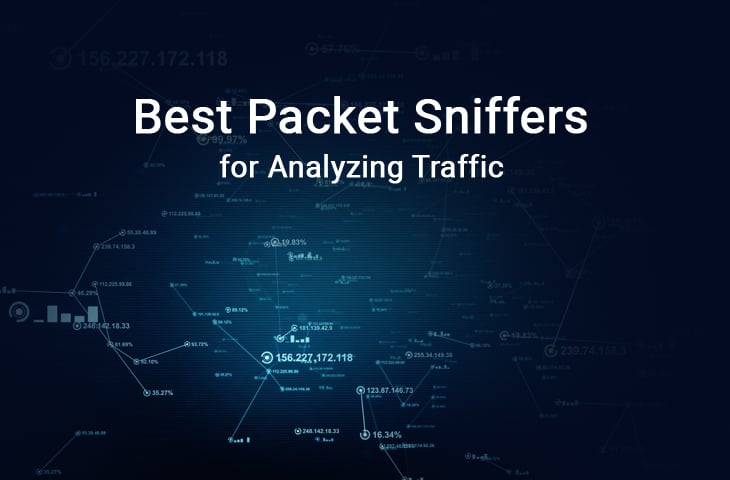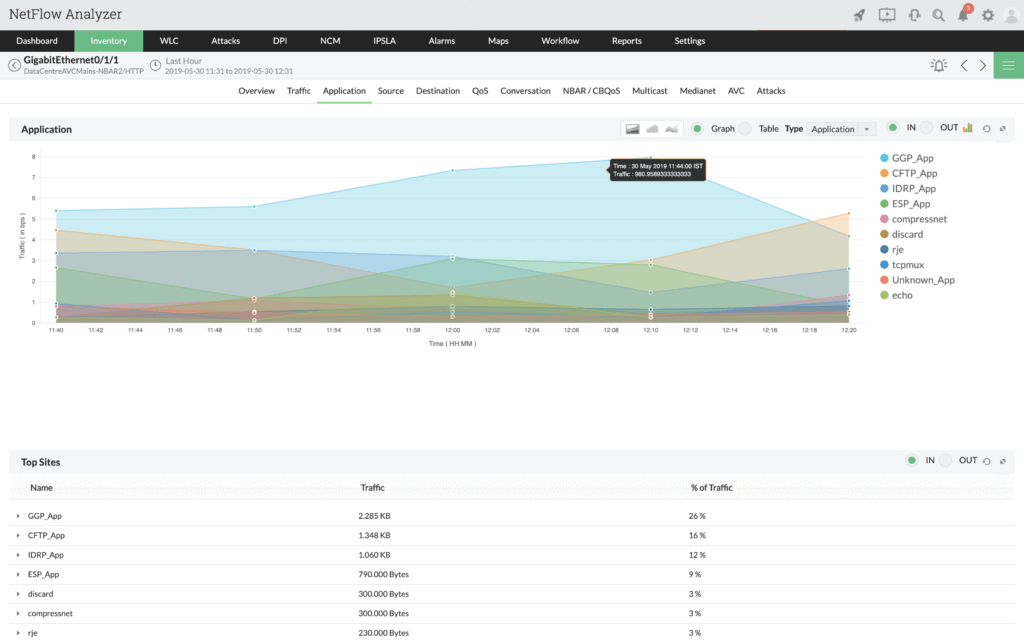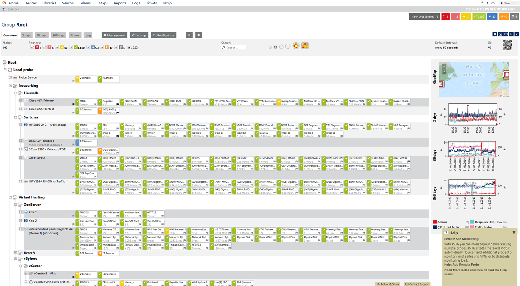Packet Sniffers are used in many different situations, networks, troubleshooting and investigative scenarios.
We've compiled a large list of the Best Packet Sniffer Software & Tools for you to use in your daily network administration tasks.
If you have been an IT Administrator for any length of time, you know that one of the most frustrating and time-consuming tasks is troubleshooting network problems.
In a company, big or small, network resiliency is of utmost importance especially in companies which rely on the internet and network connections for daily tasks.
That is why in events of network failure, it's the responsibility of an IT Administrator to troubleshoot and fix the problem as soon as possible – Each minute wasted is equal to money lost by the company.
Everyone involved in the IT industry knows for a fact that most of the time, traditional troubleshooting is either a hit or miss.
Sometimes, you might think that you have already fixed the problem but only caused a more significant network mishap because you mis-configured a server or network link.
To avoid these unfortunate events, Packet Sniffers were developed.
A Packet Sniffer is a piece of software or tool that analyzes and tracks inbound and outbound packets, monitors the network traffic and intercepts packets as well as records the path taken by the packet, and etc.
It is also used to monitor the traffic of your servers, router/switch monitoring, and other network hardware used in the company.
The information gathered from a Packet Sniffer will significantly help a Network Administrator troubleshoot and fix network errors in a smaller span of time by understanding what is going over the wire as well as source/destinations.
Packet Sniffers are used for some of the following tasks:
- Pinpointing High Bandwidth Users/Applications
- Troubleshooting Network Connectivity Issues
- Resolving DNS Issues
- Capacity Planning
- Malware Analysis and Prevent
- Active and Passive IDS and IPS
- and many more uses!
Listed below are some of Packet Sniffers, their features, pricing and other capabilities that they offer.
The Best Packet Sniffing & Analysis Tools
1. ManageEngine NetFlow Analyzer – FREE TRIAL
ManageEngine NetFlow Analyzer tool gives you the option to monitor and analyze traffic quickly from multiple protocol sources and allow you to dig into the packet flow to get a better understanding what is going on within your network.
They have refined this tool to give users and administrators a deep and intricate look into their network traffic by utilizing the following protocols:
- Netflow
- sFlow
- IPFIX
- Netstream
- J-Flow
- Appflow
- and many other protocols
Learn to better understand the traffic that is going through your network, as well as which applications are causing network bottlenecks and which ones need higher priority (QOS).
Pros:
- Supports multiple protocols like NetFlow, great for monitoring Cisco equipment
- Both tools work well alongside each other to help view traffic patterns and bandwidth usage
- Easy to use interface automatically highlights bandwidth hogs and other network traffic outliers
- Scale well, designed for large enterprise networks
- Can view traffic on a per-hop basis, allowing for granular traffic analysis
Cons:
- Built for enterprise use, not designed for small home networks
You can start by registering for a 30-day free trial.
2. PRTG Network Monitor – FREE TRIAL
PRTG is a professional network Monitoring software which has packet sniffing capabilities that provides a graphical overview of your network and allow you to monitor data packets. It filters according to IP addresses, protocols, and types of data.
It is Windows compatible and it uses different technologies including SNMP, Netflow, WMI, REST APIs for network traffic sniffing.
One of the main features that PRTG offers is the Dashboard which shows complete information about which applications uses the most bandwidth, and how much network traffic it causes in a quick and easy layout.
PRTG is often compared to other Network Monitoring solutions and its features outweigh many open source alternatives.
Another main feature offered by PRTG is the Packet Sniffer Sensor which tracks the packet and records the headers of each data packet. It can monitor:
- Total traffic
- Port sniffer
- Web traffic (HTTP, HTTPS)
- Mail traffic (IMAP, POP3, SMTP)
- File transfer traffic (FTP, P2P)
- Infrastructure traffic (DHCP, DNS, ICMP, SNMP)
- Remote control (RDP, SSH, VNC)
- Other UDP and TCP traffic
Pros:
- Uses a combination of packet sniffing, WMI, and SNMP to report network performance as well as discover new devices
- Autodiscovery reflects the latest inventory changes almost instantaneously
- Drag and drop editor makes it easy to build custom views and reports
- Supports a wide range of alert mediums such as SMS, email, and third-party integration
- Supports a freeware version
Cons:
- Is a very comprehensive platform with many features and moving parts that require time to learn
Start with a 30-day free trial download.
3. WireShark
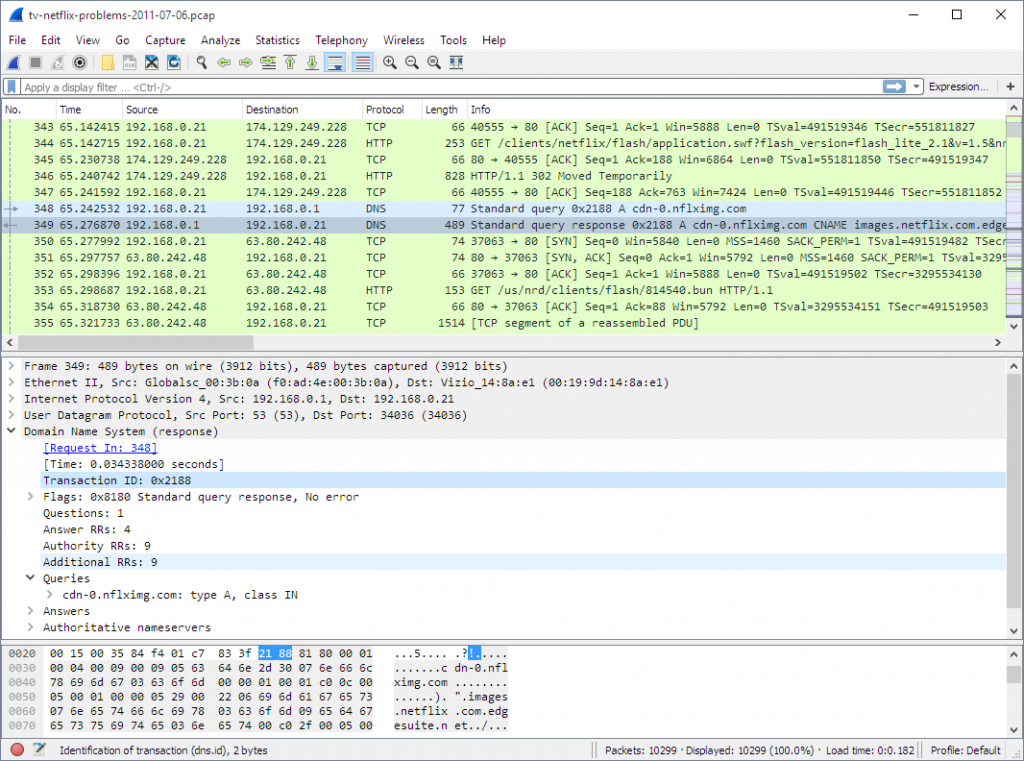
WireShark is a widely-used network protocol analyzer that lets you monitor every detail about your network and the packet flow going through it.
WireShark offers a lot of features including:
- Live capture and offline analysis
- Standard three-packet browser
- Rich VoIP analysis
- Read/write many different file formats
- Captures file compressed with gzip
- Decryption support for many protocols, including IPsec, ISAKMP, Kerberos, SNMPv3, SSL/TLS, WEP, and WPA/WPA2
- Multi-platform: Runs on Windows, Linux, macOS, Solaris, FreeBSD, NetBSD, and many others
Wireshark is completely free and easy to use as well as provide features like customizable reports, advanced triggers, filtering and alerts.
Pros:
- One of the most popular packet analyzer tools, with a massive community behind it
- Open source project that adds new features and plugins
- Supports packet collection and analysis in the same program
- Completely free
Cons:
- Has a steep learning curve, designed for network professionals
- Filtering can take time to learn, collects everything by default which can be overwhelming on large networks
Grab Wireshark completely FREE and get started analyzing packet flow immediately!
4. SolarWinds Network Bandwidth Analyzer Pack
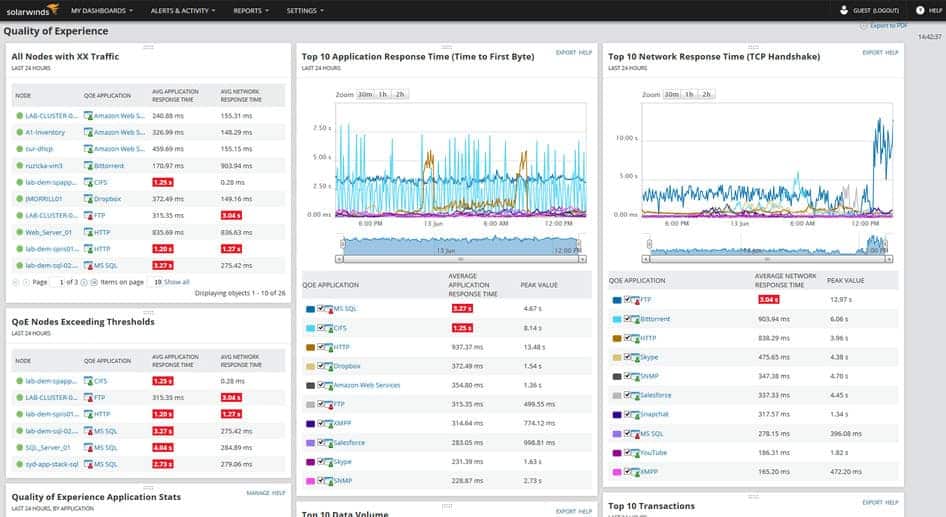
SolarWinds offers many types of IT management tools including the Deep Packet Inspection and Analysis Tool that are part of the Bandwidth Analyzer Pack.
The Deep Packet Inspection and Analysis tool offers critical packet information.
It inspects all the contents of the packet to determine even the smallest detail including what applications cause the most traffic within the network and which connections take the longest – furthermore diagnosing bottlenecks in slow internet/network connectivity.
The Bandwidth Analyzer Pack contains two very useful applications for network administration: Network Performance Monitor and Netflow Traffic Analyzer.
Network Performance Monitor runs an informative dashboard that will help you monitor network availability and response time.
It can also detect and resolve minor network performance issues. Netflow Traffic Analyzer can determine users and the specific applications that consume the most bandwidth within the network.
It can also analyze flow data such as Cisco® NetFlow™, IPFIX, sFlow®, Huawei NetStream™, Juniper® J-Flow, etc.
Pros:
- Great interface that balances visualizations and key insights well
- Highly customizable reports, dashboards, and monitoring tools
- Uses simple QoS rules for quick traffic shaping
- Built with large networks in mind, can scale to 50,000 flows
- Available for both Linux and Windows
Cons:
- Is a highly specialized suite of tools designed for network professionals, not designed for non-technical users
We highly Recommend SolarWinds for Network Management and Monitoring as well as Deep packet analysis for your networks – They are a Very well rounded company with product offerings far beyond most other software in the field, and they even offer Flow or Traffic Generation software that helps you setup and troubleshoot software as well!
Get Started with a 30-day free trial!
5. Steel Central Packet Analyzer
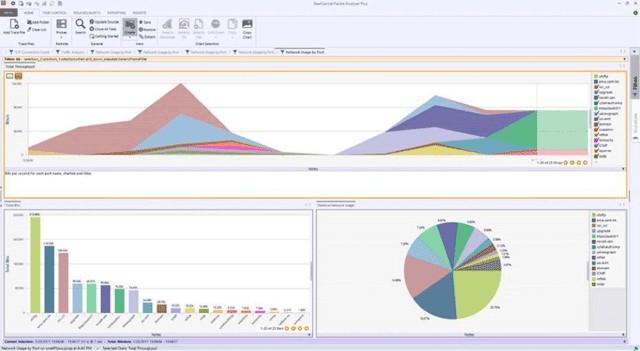
Steel Central Packet Analyzer offers an interactive graphical user interface that helps you identify the root network problem using a wide selection of pre-defined analysis views.
It provides packet sniffing down to the bit level through Packet Analyzer Plus’ full integration with Wireshark.
There are three versions of Steel Central Packet Analyzer that only differs in which products they support.
For personal networks, there is the Steel Central Packet Analyzer Personal Edition which offers the same level of packet sniffing but has a limited set of included features.
For small companies, Steel Central Packet Analyzer supports multiple products including NetShark Virtual Edition on SteelHead and SteelFusion.
Pros:
- A simple and elegant interface makes it easy to view network traffic at a glance
- Dashboards can be customized through drag-and-drop widgets
- Integrates well with tools like Wireshark, making it a great option for additional visualization of data
Cons:
- Could benefit from more integration options
- Must contact the sales team for pricing details
Steel Central Packet Analyzer Plus is highly recommended for large companies with substantial network traffic since it can support the new Steel Central AppResponse 11. Download the free trial.
6. Tcpdump
Tcpdump is a command-line tool that was initially designed for UNIX systems and is often pre-installed on almost all Unix-like operating systems.
Tcpdump does not have an attractive user interface, but all packet information needed to determine the source of the network problem can be seen on display.
Since it is a command-line packet sniffing tool, you do not need to have a heavy duty PC to run it smoothly, as you can literally fire up the command line tool and start sniffing fairly quickly.
There is a bit of a learning curve though and its not nearly as intuitive as other programs in this list.
Tcpdump uses very basic to complex codes and commands so it would take time to master how to operate this tool fully.
But once you get the hang of it, it would be straightforward for an IT administrator to get around and identify the causes of network issues. It has been ported to Windows as Windump.
Pros:
- Open-source tool backed by a large and dedicated community
- Simple syntax is easy to learn, especially for users who are comfortable with CLI tools
- Lightweight application utilizes CLI for most commands
- Completely free
Cons:
- Packet capture can only be read by applications that can read pcap files, not saved in plain text files
Check out the latest releases for download.
7. NetworkMiner
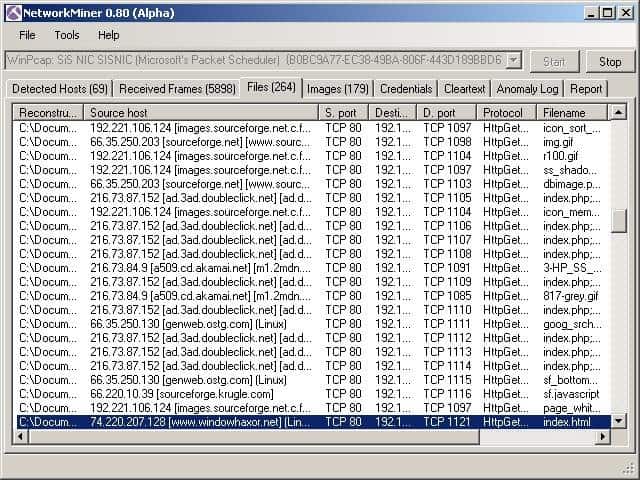
NetworkMiner for Windows makes network analysis very simple and can detect the host-name as well as the OS and open ports of network hosts through packet sniffing.
It can also operate offline by parsing a PCAP file for further analysis and reassemble sent certificates from PCAP files.
Pros:
- Acts as a forensic tool as well as packet sniffer
- Can reconstruct files and packets over TCP streams
- Does not introduce any noise to the network while in use, good for avoiding cross contamination
- Free to use, includes a paid version for more advanced features
- Offers a GUI rather than only CLI
Cons:
- The interface is antiquated, and can be difficult to navigate at times
NetworkMiner was released in 2007 by Netresec and since its release, it has been a widely-used tool by companies and organizations all over the world. Check out their latest release.
8. Kismet
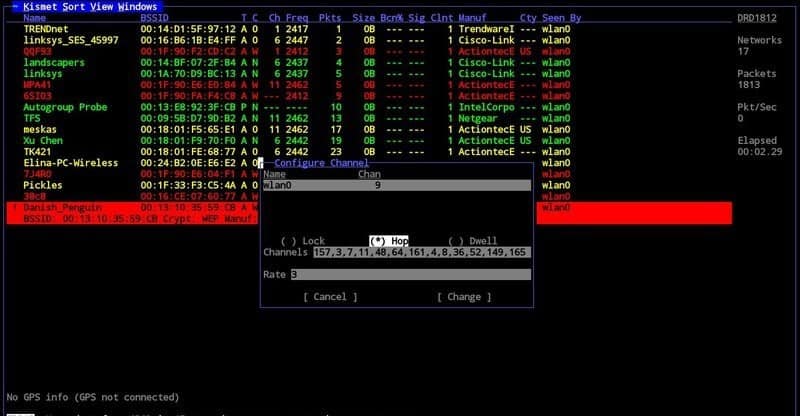
In this day and age where wireless networks are in high demand, Kismet can work wonders in packet sniffing since it was developed specifically for wireless networks.
It can detect and sniff packet even from hidden networks and SSIDs.
It can detect the presence of wireless APs as well as clients and what kind of traffic they create – this is especially useful for creating WiFi Heat Maps and such.
Kismet also has a counterpart that is compatible with MAC and OSX environments, KisMAC. They both have simple and easy-to-learn user interfaces.
Pros:
- Available for Linux, Mac, and OpenBSD
- Can scan for Bluetooth signals along with other wireless protocols outside of Wifi
- Allows for real-time packet capture that can be forwarded to multiple team members
- Uses plugins for additional features keeps the base installation lightweight
- Free to use
Cons:
- Designed for smaller networks
- Lacks enterprise-level reporting capabilities
Download and explore the latest release.
9. Fiddler
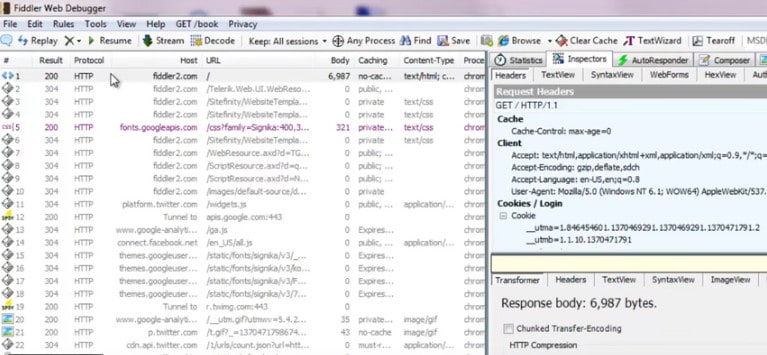
Fiddler is not technically made for packet sniffing but can be used either way. It can manipulate and log HTTP/HTTPS traffic.
May it be on a desktop or on non-web applications, as long as it uses HTTP/HTTPS for connections, Fiddler can analyze the traffic and help you determine which causes the heaviest network traffic.
Since it is an open source tool, administrators use Fiddler to isolate performance bottlenecks. It also offers web debugging and HTTPS traffic decryption.
Pros:
- Focused on capturing only HTTP traffic, allowing for a more focused and less complex solution
- Ideal for those looking into the security and communications of the HTTP protocol
- Can discover all HTTP traffic, not just limited to browsers
- Is completely free
- Offers a GUI for those who want more than a CLI tool
Cons:
- Steeper learning curve than similar tools
Download the latest release.
10. EtherApe
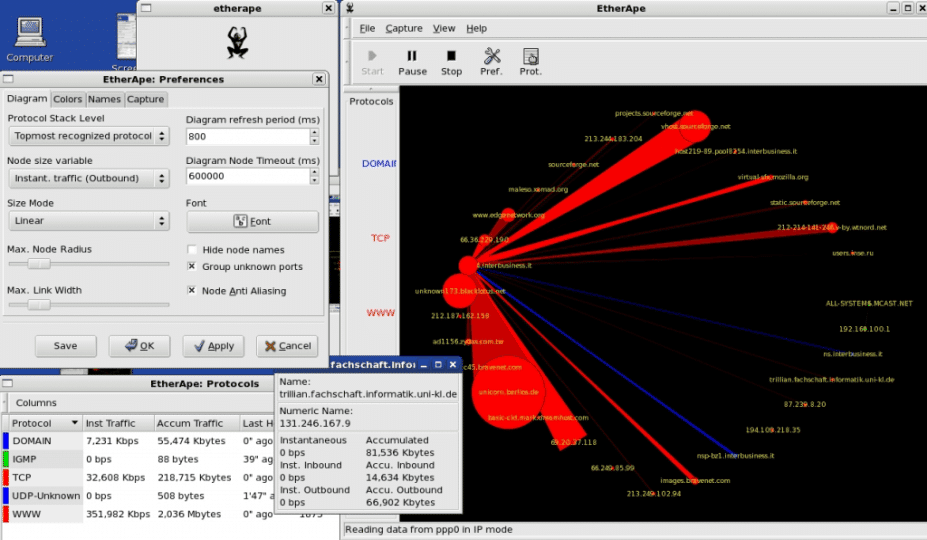
Fundamentally, EtherApe and WireShark offer the same features, but they differ in the representation of data.
Some features offered by EtherApe include but are not limited to:
• Protocol summary dialog shows global traffic statistics by protocol.
• Node summary dialog shows traffic statistics by node.
• Node statistics export to XML file.
• A single node can be centered on the display and several user-chosen nodes can be arranged in an inner circle with other nodes around.
• An alternative display mode arranges nodes in “columns”.
This open-source packet sniffer is more focused on giving a visual interpretation of the information on the packets. The data displayed can be changed to show only the data you need.
Pros:
- Complete free
- Continuously updated
- Leverages simple but powerful data visualization to display information natively
- An open-source project
Cons:
- Only available for Linux, Unix, and MacOS
Check out their official download page.
11. Packet Capture
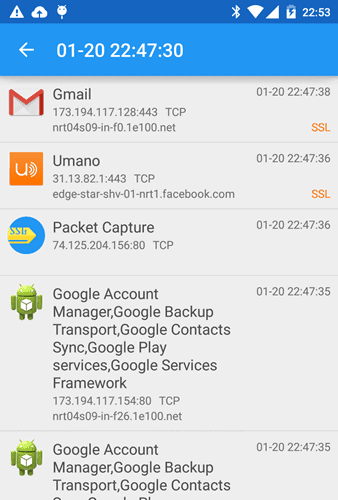
As society moves to mobile devices, integration and sniffing of the Android platform is a definite must.
Packet Capture app can record and capture network packets using a local VPN. SSL communication can be decrypted using the Man In The Middle (MITM) approach.
Pros:
- Great option for mobile technicians
- Includes robust packet capturing
- Can recreate MITM attacks – great for audits
- Is completely free
Cons:
- Not available for iOS
- Contains ads
It can be downloaded straight from the Play Store and it uses a basic, yet informative user interface. It focuses on your HTTPS traffic and records all the packets that come through the connection. This android application is free of charge but will contain ads.
Conclusion
The use of these Packet Sniffers and Network Analyzers will help you identify and resolve network issues in a shorter amount of time.
The insight these applications provide are invaluable in large and complex networks that need constant monitoring and analysis.
All the time you spent digging down to the lowest level of the OSI model to find that problematic packet can be easily saved by the use of one of these listed applications.
Monitoring network traffic is a breeze, and prevention of network congestion, before it happens, is now a reality.
Grab one of the free Downloads or Trials from above and starting analyzing and Sniffing Packets & network traffic today!
Packet Sniffing Tools FAQs
What are some common use cases for packet sniffers?
Common use cases for packet sniffers include network troubleshooting, security monitoring, performance analysis, and application debugging.
What types of information can be obtained with packet sniffers?
Packet sniffers can provide a wide range of information about network traffic, including protocol headers, packet contents, IP addresses, port numbers, and timing information.
What are some popular packet sniffers?
Some popular packet sniffers include Wireshark, tcpdump, and Microsoft Network Monitor.
How do packet sniffers capture network traffic?
Packet sniffers capture network traffic by placing the network interface card (NIC) of a device into promiscuous mode, allowing it to capture all traffic on the network, including traffic not intended for that device.
Can packet sniffers be used for malicious purposes?
Yes, packet sniffers can be used for malicious purposes, such as capturing sensitive information and passwords, and launching denial-of-service attacks. It is important to use packet sniffers only for legitimate and authorized purposes, and to follow all applicable laws and policies related to network monitoring and security.
What types of filters can be applied to captured packets in packet sniffers?
Packet sniffers can apply a range of filters to captured packets, including filters based on protocol, IP address, port number, and timing information.
What types of output formats are supported by packet sniffers?
Packet sniffers can support a range of output formats, including text, CSV, and HTML. Some packet sniffers can also export captured packets in a format that can be read by other network monitoring tools.
What are some key features to look for in packet sniffers?
Some key features to look for in packet sniffers include the ability to analyze multiple protocols, customizable notifications, real-time packet monitoring, and integration with other monitoring tools.
Related Post: Best Network Traffic Generator

